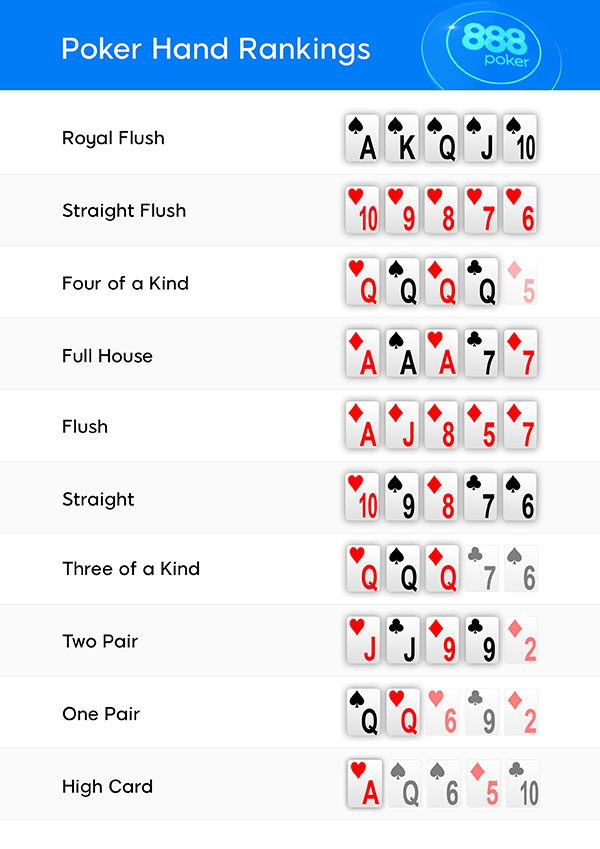How to Play Poker in 10 Quick Steps
It has been said that poker takes a few minutes to learn, but a lifetime to master. Fortunately, the learning curve begins with your very first hand. With skill, strategy, and practice, any competent player can become proficient at the game of poker. Let’s take a look at how to play poker in 10 easy steps.
Step #1 – Learn the Poker Hand Rankings
Most games of poker require players to form the strongest-value hand. This is typically comprised of a combination of hole cards (pocket cards) and community cards. Poker is a game of smarts, mental toughness, and attrition – but it’s also a numbers game. Since the highest-ranking hand typically wins the pot, it’s important to understand hand rankings.
The best hand you can form in a game of poker is a Royal Flush (10-Jack-Queen-King-Ace of the same suit). This is followed by a Straight Flush, Four of a Kind, Full House, Flash, Straight, Three of a Kind, Two Pair, One Pair, and a High Card. Whether you’re a newbie or a pro, always aim for the best hand!
Step #2 – Effective Bankroll Management
Perhaps the most important lesson you’ll ever learn in poker is bankroll management. The best poker players are adept at managing their money well. Only gamble with what you can afford to lose, and only play games that you can afford. This means choosing your buy-ins carefully, and your types of poker games.
For example, experts advise a minimum bankroll of 30 buy-ins for NLH, 50 buy-ins for a medium-size bankroll, and 100 buy-ins for a bigger bankroll. The bigger your bankroll, and the better it is managed, the less likely you will be to drop your betting stakes during your poker sessions. Your bankroll always determines the stakes that you play at.
Step #3 – Only Play Strong Starting Hands
Many newbie poker players are so eager to cash in on the action that they play too many starting hands. That is a recipe for disaster. The precise percentage of hands that you should play pre-flop depends on the specific game in question, the actions taken by your opponents, and your intuition.
As a rule, if it’s good enough to call, it’s equally good to raise. It’s a great idea to use a starting hands chart to help improve your poker game. Certain hands like Ace-Ace, King-King, Queen-Queen, Jack-Jack, 10-10 etc. can be played in any position, while certain hands like 3-2, 4-3, and 4-2 are virtually unplayable. The odds of winning with a pair of pocket rockets are 85% – food for thought!
Step #4 – Table Positions: Where You Sit Matters
A seat is a seat, right? In poker games, where you sit is important. In the real estate world, it’s called location, location, location. In poker, its position, position, position. Everything centers around the Button in poker games, except for Stud poker. Early Position players (EP) include the Small Blind and the Big Blind.
These are located left of the button, and they are first to act after the first 3 community cards have been dealt – the Flop. Seats located right of the button are known as Late Position (LP) and they are last to act. Middle Position seats are between Early Position and Late Position. In poker, the best positions are the last to act post-flop. Why? Because you get to see what everybody else is doing before you act.
Step #5 – Starting with the Pre-Flop Play
The poker player seated immediately to the left of the Big Blind initiates the pre-Flop action. The play continues in a clockwise fashion around the table, with the Big Blind being last to act. During the pre-Flop session of the game, each poker player can fold, call or raise. As soon as players have acted, and the poker pot has been seeded, the betting round ends,
Step #6 – Continuing with the Post-Flop Play
The first 3 community cards dealt into the center of the table for all players to use are known as the Flop. In total, there are 5 community cards in poker games, with the Turn and the River making up the rest. Once the first 3 community cards have been dealt, players can check (make no bets), call, bet, raise, or fold. Your decision is based upon the strength of your starting hand, your position at the table, and the actions taken by other players.
Step #7 – Post-Turn Poker Play
After the post-Flop betting round comes the Turn. This is the fourth community card dealt. At this point, you have the same actions available to you as the pre-Flop. These include bet, call, raise, fold, or check. Your decision to take any of these actions is based on your table position, prior actions you’ve taken, and your intuition.
Step #8 – Down the River We Go
The River is the fifth and final community card dealt in a game of poker. You’ve made it this far, so you probably have a hand that can win the pot. If you’ve kept a stone-cold poker face, you can bluff your way to victory. Provided everyone checks, you can raise the stakes and push for a big win.
Step #9 – The Showdown: The Final Stretch
If 2 or more players remain in the hand, a showdown ensues. At this stage, the winner is the one who has the strongest 5-card poker hand. In Omaha Hi-Lo or Seven Card Stud Hi-Lo, the player with the qualifying low hand will snatch victory. Generally, the player with the highest ranking 5-card hand is crowned the winner and enjoys the spoils of victory.
Step #10 – Ante Up for a New Round of Poker
The end of one game is simply the beginning of another. Poker players are always eager to jump right back into the action. Win or lose, you always gain valuable knowledge from your online poker sessions. 888poker offers an exciting selection of poker games including cash games, SNGs, MTTs, Omaha Hi, Omaha Hi-Lo, Texas Hold’em, Seven Card Stud, and SNAP poker.

The 4 Pillars of Effective Poker Play
- Poker Hands
-
Every poker hand in the game is ranked according to a hand ranking system. The highest-ranking poker hand is a Royal Flush – 10-Jack-Queen-King-Ace of the same suit. The lowest poker hand you can form is a High Card. It’s important to understand how your hand ranks relative to other hands at the table. This will help you to form winning combinations, and enhance your decisions with holding, folding, betting, raising, re-raising, and going all in. Find out everything you need to know with our comprehensive poker hand guide.
- Poker Lingo
-
Poker is the ultimate game of skill, wit and strategy. It’s also laden with unique terms, phrases, and jargon. We’ll teach you all the poker lingo you need to know so that you can stay on top of your game online, or at live poker tables. Next time somebody asks you whether you’re under the gun with a pair of cowboys, or holding the nuts on the river, you’ll know exactly what that means. We’ll teach you how to speak poker, sleep poker, and think poker. For everything you need to know, check out our poker terminology guide.
- Poker Strategy
-
Poker is a game of skill. You will need to employ effective tactics and strategies to maximize your success at the tables. Whether you’re a newbie or an experienced professional, we will teach you how to optimize your game plan with basic strategy, and advanced strategy. Once you know the rules of play, you’ll be a much stronger poker player. Boost your bankroll and your understanding of the game with our poker strategy guide.
- Poker Rules
-
Once you understand the rules of play, you will be in a much stronger position at the poker table. Whether you’re playing Texas Hold’em, Omaha Hi, Omaha Hi-Lo, or 7-Card Stud, it’s essential to understand the rules. When you know the rules of play for each game, you will be better positioned when you bet, raise, re-raise, call, or fold. The rules form the bedrock upon which your poker strategy is based. For everything you need to know, check out our poker rules guide.
Your Guide to Playing Poker Games
- Texas Hold’em Poker
-
Looking for some razzle-dazzle at the poker tables? We’re about to introduce you to the ultimate poker game – Texas Hold’em Poker. This game outranks all others by a long margin, and for good reason. It is the game of choice at the Main Event of the World Series of Poker (WSOP). What’s it all about? You must form the strongest 5 card hand at the table. You’re dealt 2 hole cards, and the board includes The Flop, Turn, and River.
Want more info? Check out our Texas Hold’em Poker Guide
- Omaha Hi Poker
-
Omaha Hi, otherwise known as PLO (Pot Limit Omaha) is a hot favorite with poker players. This exciting game is played with 4 pocket cards (hole cards), not 2. Your goal is to compile the best 5 card hand using only 2 pocket cards and 3 cards from the board. The community cards include The Flop (the first 3 cards), The Turn (the fourth community card), and the River (the fifth and final community card). Omaha Hi poker differs from Texas Hold’em in that you can’t simply play the board – you must use at least 2 hole cards. Holding 4 clubs in your hand? You can only use 2 of those cards to form your Flush.
Want more info? Check out our Omaha Hi Poker Guide
- Stud Poker
-
7 Card Stud is a classic poker game. Everyone at the table receives 7 cards, and there are no community cards to play with. With 7 Card Stud, you’re only allowed to use the cards on your board to form the best-ranking hand. This strategic game includes pre-flop antes, bring in bets, and plenty of action over 5 streets. Since there are many more betting rounds than a typical game of Texas Hold’em, it’s important to understand the rules of play for 7 Card Stud poker.
- Omaha Hi-Lo
-
The beauty of playing Omaha Hi-Lo is that you get to compete for the Hi Hand and the Lo Hand. The poker pot is split down the middle for the Hi Hand winner and the Lo Hand winner. To win the Lo Hand, you must form a 5-card hand with card values lower than 8. Remember, only 2 of the 4 pocket cards can be used in addition to 3 of the 5 community cards (Flop, Turn, and River). If you scoop up the Hi and the Lo, you will win 100% of the pot!
Want more info? Check out our Omaha Hi-Lo Poker Guide
Differences Between Playing Poker Online vs Playing Poker Offline
Poker players often question the difference between playing online versus playing offline. Believe it or not, it’s not just reading your opponent’s face that determines how you act – there are many other factors. Fortunately, table position, betting patterns, and speed of decision-making, allow players to understand one another.
Playing poker online is fast & furious, with no time wasted between hands, changing chips and getting dealt in. Live poker is a social experience, and face-to-face interactions are the norm. At 888poker, you get to enjoy both in a highly social environment with real-time poker games and Face2Face poker. With cards in hand and chips on the line, online poker is as real as it gets!















